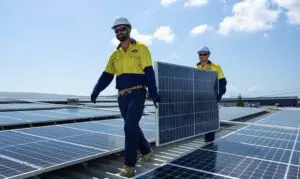Victorian energy minister Lily D’Ambrosio deserves credit for taking a stand.
Today, she announced that Victoria will not support capacity payments to existing coal and gas generators that would slow the transition to renewable energy.
The Minister’s strong position sends a clear message to her federal counterpart that the states are serious about supporting the clean energy transition.
It also shows they won’t be distracted from what should be Australia’s main goal which is to halve emissions and have 50% renewables by 2030.
The Energy Security Board’s (ESB) recommendation to subsidise coal-fired power stations by introducing a decentralised capacity mechanism, referred to as a Physical Retailer Reliability Obligation (PRRO), is completely counterproductive to Australia’s renewable energy sector and would impose unnecessary costs on customers and undermine investor confidence in new generation and storage capacity.
It’s encouraging that the Minister’s position is that any new capacity mechanism must support zero emissions technologies and be consistent with our nation’s emission reduction targets.
We will need market signals that will encourage new generation and flexible firming technologies to come into the market in time to replace traditional dispatchable generators as they exit the market.
But this needs to happen in a way that keeps costs to consumers down and facilitates a smooth transition.
The PRRO is not an effective mechanism for achieving this.
The reality is investment in renewable projects has been progressing rapidly and, in some states, exceeding expectations.
As the Australian Energy Market Operator recently noted, about 3.7 gigawatts of new gas, battery and hydro projects are set to enter the market in coming years. This is on top of 3.2 gigawatts of new wind and solar under construction.
Together, this totals more than four times the operating capacity of AGL’s Liddell coal plant in NSW alone.
There is no evidence to suggest the industry will fail to deliver on its capacity or that we need coal to ensure reliability.
Just last week, the NSW energy minister Matt Kean’s said his state can “absolutely stop using coal power by 2030”, a position apparently at odds with the Federal Energy Minister Angus Taylor who has backed the ESB’s recommendations.
Let’s not forget why the ESB was created: to steer national reforms and to help coordinate the pre-existing energy regulatory bodies of AEMO, AEMC and AER. The board was set up as a short-term fix, and was not supposed to be an enduring, additional layer of regulatory complication to our energy market.
It has now delivered what it set out to achieve – a new plan for the design of our energy market – and this has been delivered to ministers for final decision-making. As Australia’s energy sector moves into what is a critical decade for action on climate change, we should be asking if the ESB is the right body to help decarbonise our energy system.
The states are pressing ahead with the clean energy transition.
It’s time for the federal government to commit itself to the orderly wind up of the ESB and develop mechanism in consultation with the states and industry that rewards new flexible generation and storage.
Stephanie Bashir is a Policy Advisor and Renewable Energy Advocate.








